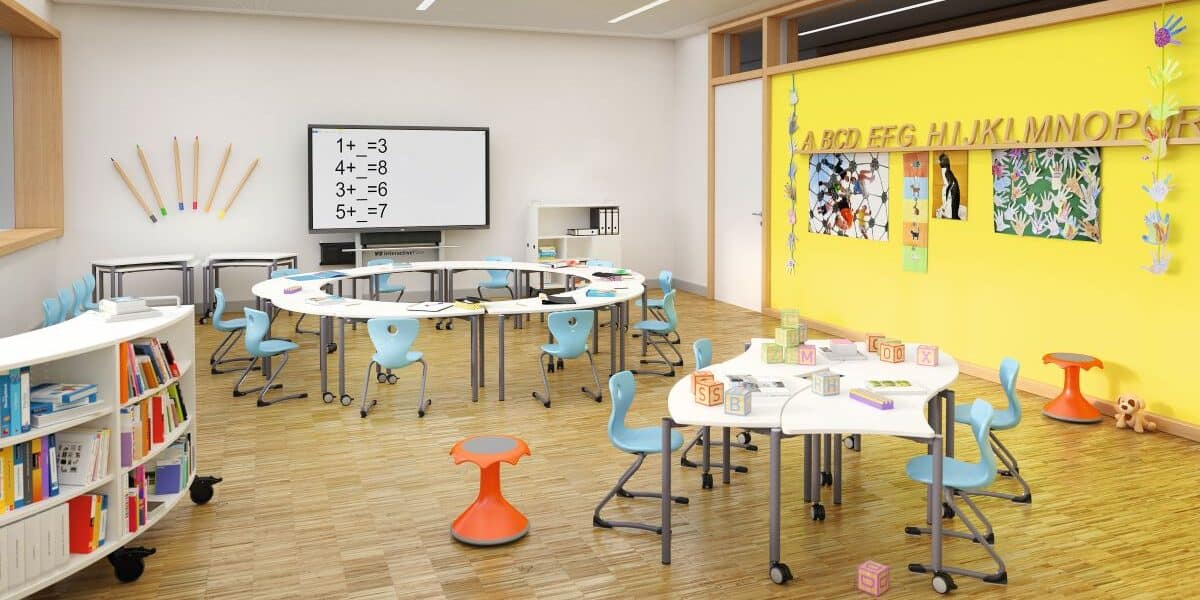Much like all industries in which innovation is highly prized, education relies on the principle of constant growth and adaptation. This is true for the student’s knowledge and understanding of the world, the ways in which instructors teach, and even in the evolution of educational programs themselves.
As an essential component of the learning experience, educational spaces and modern school furniture design are evolving, as well. With this evolution in mind, here are five design features that innovative schools utilize to achieve success.
- Versatility in Design
Gone are the days of a stiff, lifeless chair attached to a stiff, immovable desk at a fixed, uncomfortable height in a strictly forward-facing row of identical furnishings. The best school furniture design of the 21st century is smarter, more creative, and offers more versatility. It maximizes the potential for diverse uses, and it can often be adjusted or reconfigured to better suit both the user and the environment.
Why it’s important: Numerous studies have demonstrated the correlation between student well-being and flexible, ergonomic seating options. Additionally, versatile furniture is often vital in smaller or multi-purpose spaces.
How it connects to learning: Flexible, versatile seating options, as well as height-adjustable desks, mirror the contemporary emphasis on diverse tasks and learning styles.
How it’s done: Stackable desks and seating elements, mobile storage units, and easily foldable and storable teaching accessories are just a few of the ways that modern school furniture design is transforming educational settings.
- Emphasis on the Student Experience
It doesn’t take a master’s degree in early childhood education to know that the student is at the center of the learning experience. Still, this central tenet is all too often lost when it comes to furnishing classrooms. The best school furniture design places an emphasis on the physical and mental well-being of the student, allowing for a more holistic learning experience.
Why it’s important: Uncomfortable furniture detracts from student focus, creativity, and physical wellness. On the other hand, when individual students enjoy the learning experience, the entire classroom benefits.
How it connects to learning: All successful teaching methodologies, from cooperative learning to inductive strategies and beyond, have one important thing in common: student-centeredness. Students perform best when not only the teacher, but also the environment itself, offers a sense of focus and empowerment.
How it’s done: As Buckingham County Primary and Elementary Schools in Virginia discovered, modern school furniture design developed with the student at the forefront has created an environment so appealing and rewarding that “kids don’t want to go home at the end of the school day.”
- Coherence of Furnishings and the Environment
The best school furniture design isn’t about the furniture itself; it’s about crafting the ideal environment. Making sure that a given space and its furniture complement each other can have a transformative effect on the learning experience.
Why it’s important: This key principle of educational furniture design extends to both use and aesthetics. When the overall design of a space makes sense, optimal functionality naturally follows.
How it connects to learning: Modern classrooms are typically single spaces that are used for various activities. When students feel that their environment is constructive, purposeful, and that they’re prepared for the task at hand, the learning experience is dramatically improved.
How it’s done: Balance in design that extends to both environment and furnishings can be achieved by honestly evaluating your space and choosing furniture that supports a diversity of tasks and activities within that space.
- Private and Public Space
Both individual and collective learning are essential to innovations in teaching, as well as innovations in the best school furniture design. For some school environments, this is best achieved through zone design, with a natural flow to the environment. For others, especially environments in which limited space is a factor, versatile, stackable, and adjustable furniture allows for settings to rapidly convert to accommodate private and shared spaces.
Why it’s important: When students are kept in one position and configuration throughout the day, energy and attention can lag. By contrast, motion between environments allow for times of productive and reflective individual work as well as networking and team-driven activities that teach valuable social skills.
How it connects to learning: Contemporary teaching methodologies emphasize a balance of individual and group learning. Toggling between these two modes should be as effortless as possible and represent a key feature of modern school furniture design.
How it’s done: Mobile dividers and movable furniture solutions instantly transform spaces from individual-focused to social and group-oriented. By allowing furniture design to organically promote authentic collaboration, students can feel more comfortable and adept in a variety of learning styles and situations.
- A Blend of Technology and Nature
Whether a school is located in the middle of the country or the heart of the city, the best school furniture design finds a way to incorporate elements of the natural world. This idea is a guiding principle for the most notable designers of the past century and can be achieved relatively simply through the selection of materials, configuration of space, and focus on environmental balance between technology and nature.
Why it’s important: Beyond the obvious aesthetic value of blending technological and natural elements, this combination is also an innovative way to promote balance, energy, and a natural sense of calm, reducing the traditional sterility of educational settings.
How it connects to learning: The learning experience is naturally all about the future and innovation, but it’s also about freedom and play. When a student’s sense of feeling at home in his or her environment isn’t only confined to recess, the opportunities for creativity and expression are virtually limitless.
How it’s done: An outstanding example of blending classroom technology and nature is provided by Lincoln Middle School in Schiller Park, Illinois, which capitalizes on natural light and gravitates toward warm, natural wood and clean materials. These elements, combined with versatile, innovative spatial configurations, emphasis on the student, and furnishings for a truly contemporary educational environment, reflect the best of modern school furniture design.
This information is courtesy of VS America, which, as a full-service manufacturer, covers both the schools sectors and the office living and working space with intelligent furniture and integrative solutions, www.vsamerica.com.









